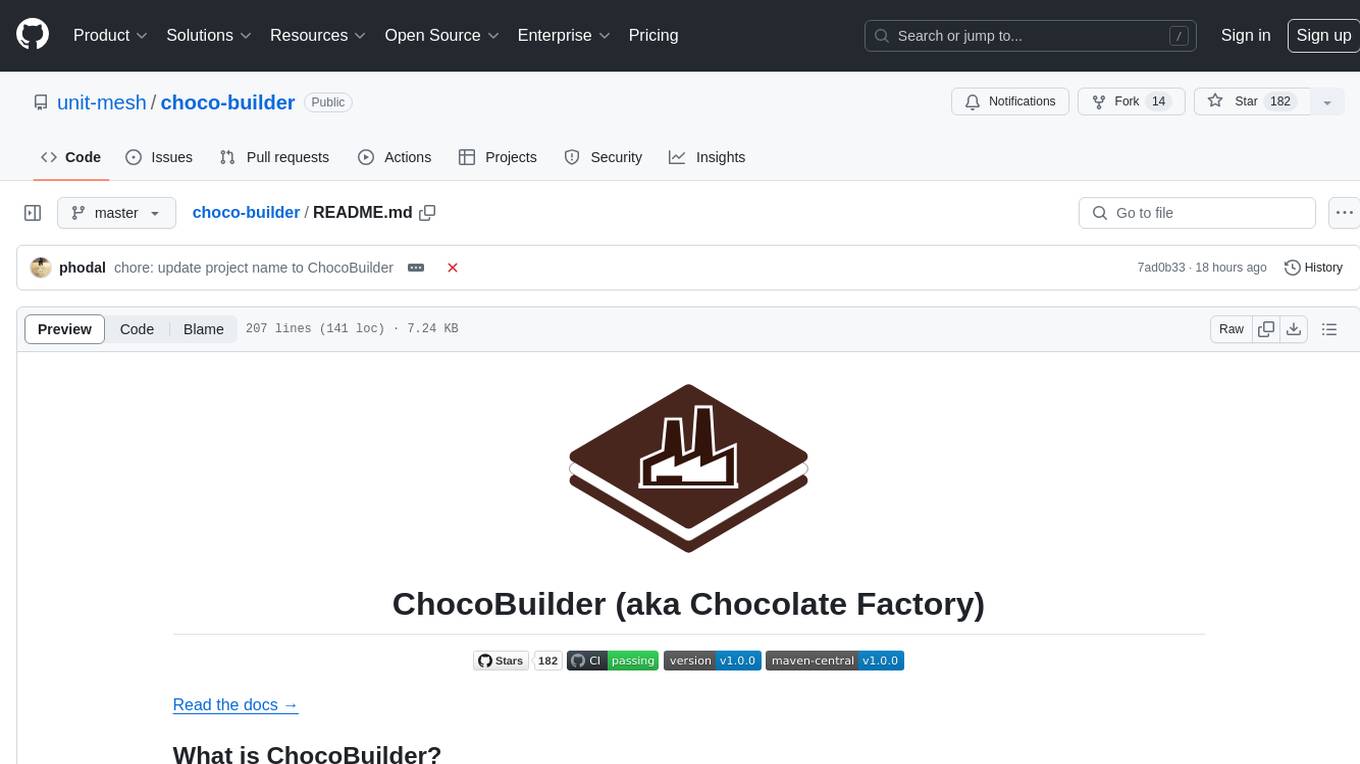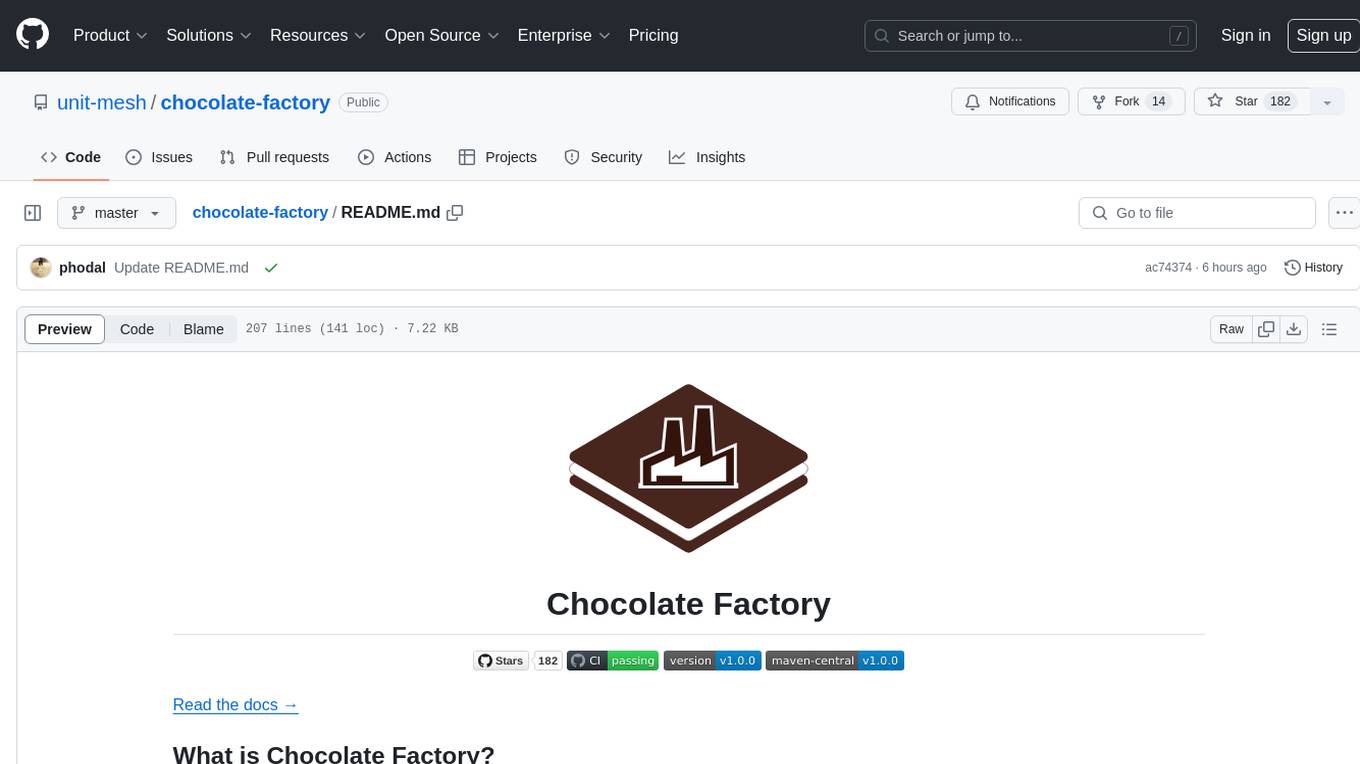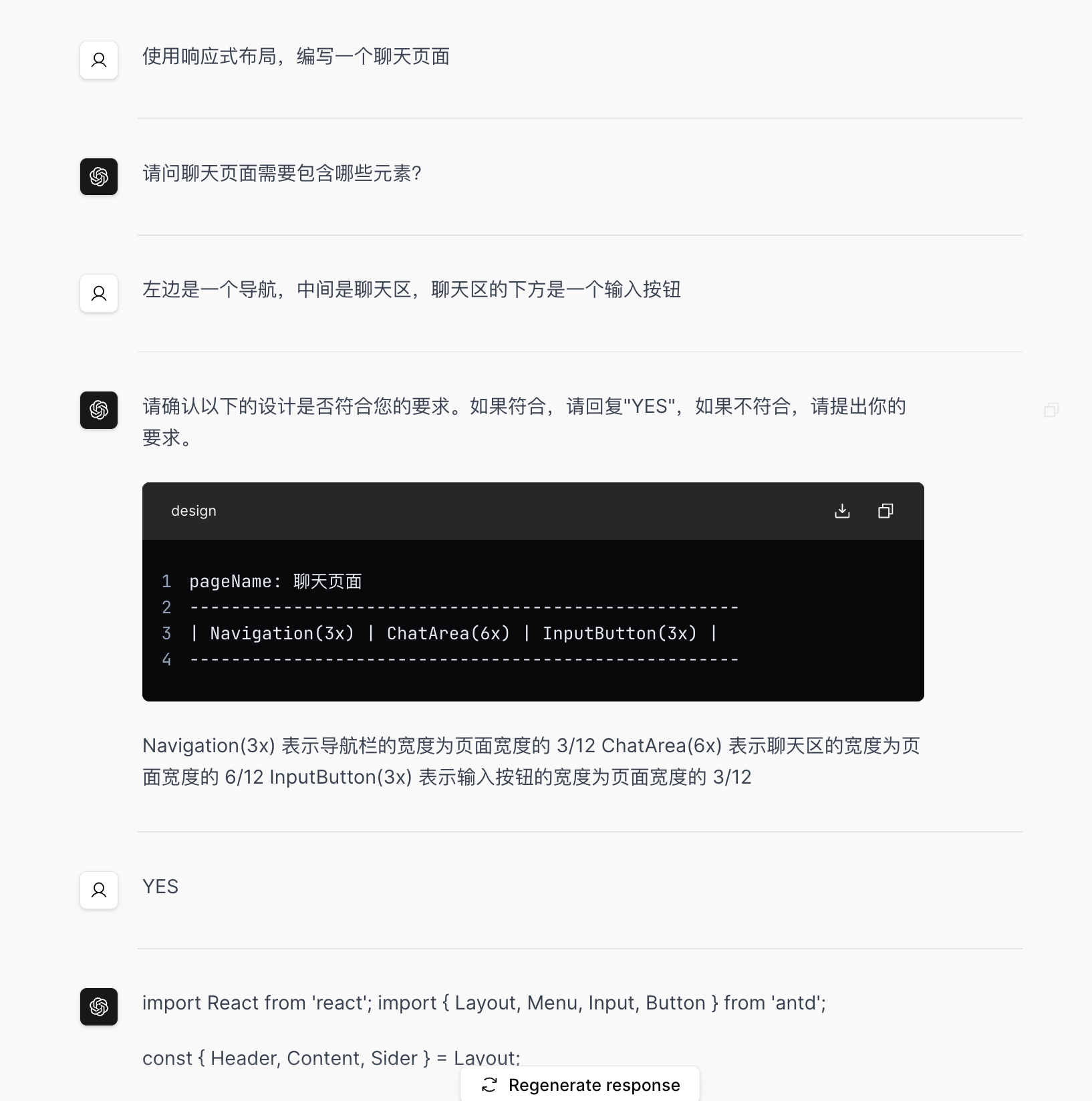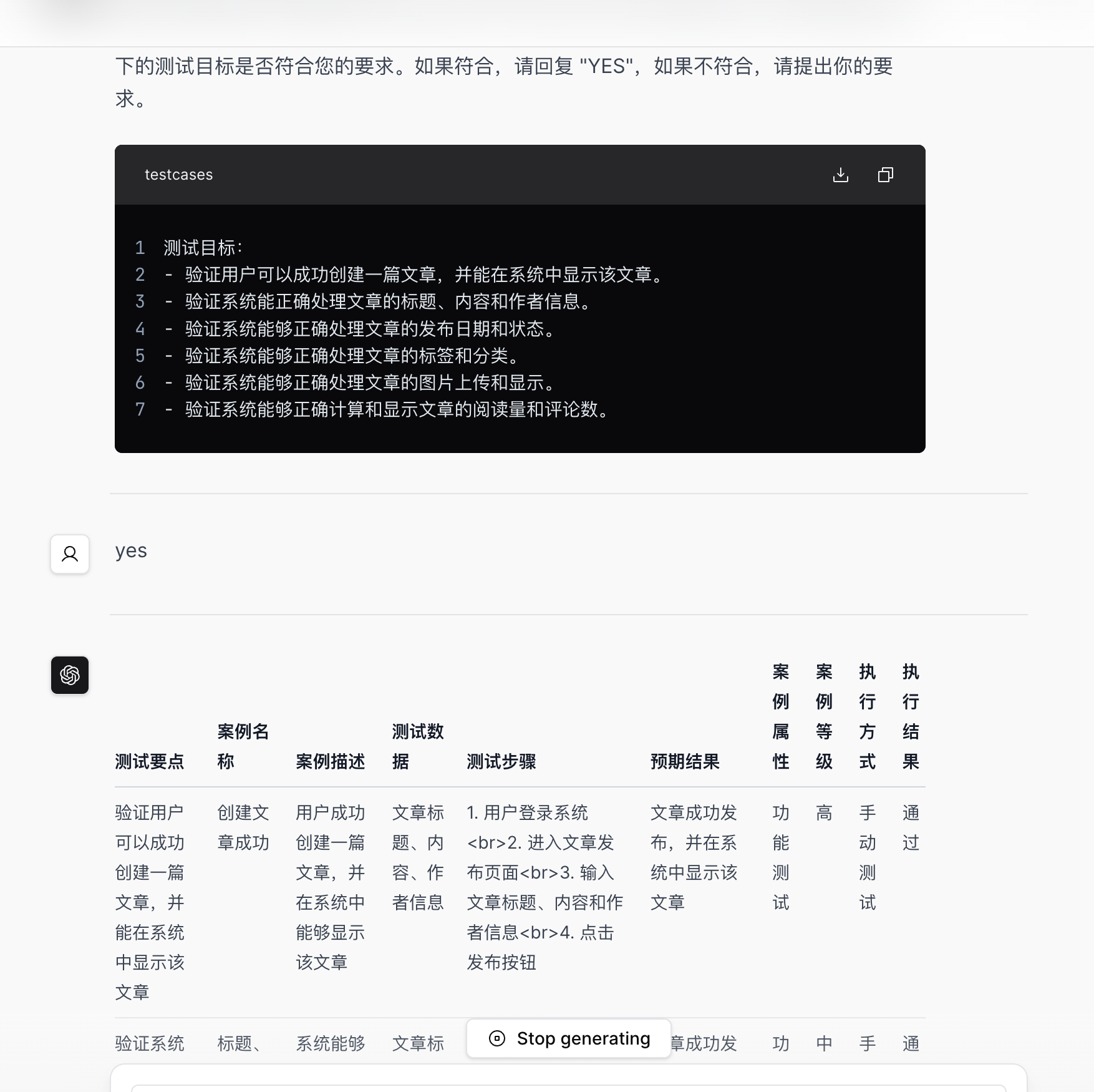
choco-builder
ChocoBuilder (Chocolate Factory) is a cutting-edge LLM toolkit designed to empower you in creating your very own AI assistant.Chocolate Factory 是一款开源的 LLM 应用开发框架,旨在帮助您轻松打造强大的软件开发 SDLC + LLM 生成助手。无论您是需要生成前端页面、后端 API、SQL 图表,还是测试用例数据,Chocolate Factory 都能满足您的需求。
Stars: 182

ChocoBuilder (aka Chocolate Factory) is an open-source LLM application development framework designed to help you easily create powerful software development SDLC + LLM generation assistants. It provides modules for integration into JVM projects, usage with RAGScript, and local deployment examples. ChocoBuilder follows a Domain Driven Problem-Solving design philosophy with key concepts like ProblemClarifier, ProblemAnalyzer, SolutionDesigner, SolutionReviewer, and SolutionExecutor. It offers use cases for desktop/IDE, server, and Android applications, with examples for frontend design, semantic code search, testcase generation, and code interpretation.
README:
ChocoBuilder (origin Chocolate Factory) 是一款开源的 LLM 应用开发框架,旨在帮助您轻松打造强大的软件开发 SDLC + LLM 生成助手。
For native (Android/iOS/Embedded device) SDK: see in https://github.com/unit-mesh/edge-infer
方式 1:集成到 JVM 项目中
模块列表:https://central.sonatype.com/namespace/cc.unitmesh
dependencies {
// 核心模块
implementation 'cc.unitmesh:cocoa-core:0.4.6'
// Pinecone
implementation 'cc.unitmesh:store-pinecone:0.4.6'
// ElasticSearch
implementation 'cc.unitmesh:store-elasticsearch:0.4.6'
//...其它模块
}更多示例见:examples/
方式 2:使用 RAGScript
@file:DependsOn("cc.unitmesh:rag-script:0.4.6")
import cc.unitmesh.rag.*
rag {
indexing {
val chunks = document("README.md").split()
store.indexing(chunks)
}
querying {
store.findRelevant("workflow dsl design ")
.lowInMiddle()
.also {
println(it)
}
}
}方式 3:本地部署示例
git clone https://github.com/unit-mesh/chocolate-factory
# modify OPENAI_API_KEY and OPENAI_HOST in docker-compose.yml
docker-compose upDesktop/IDE:
- https://github.com/unit-mesh/auto-dev - The AI-powered coding wizard with multilingual support 🌐, auto code generation 🏗️, and a helpful bug-slaying assistant
- https://github.com/phodal/shire - AI Coding Agent Language
Server:
Android:
See in https://framework.unitmesh.cc/ or see in documents
The key concepts of ChocoBuilder are:
(PS: Origin made by Michael Plöd at Aligning organization and architecture with strategic DDD)
A user's problem is processed by the following steps:
- Online Demo: https://framework.unitmesh.cc/ (TODO)
- Video Demo: https://www.bilibili.com/video/BV1T14y1C7p2
- Gif Demo:
- 步骤 1:ProblemClarifier:使用响应式布局,编写一个聊天页面
- 步骤 1.1:ProblemClarifier:左边是一个导航,中间是聊天区,聊天区的下方是一个输入按钮。
- 步骤 2:SolutionDesigner:请确认以下的设计是否符合您的要求。如果符合,请回复"YES",如果不符合,请提出你的要求。
- 步骤 3:SolutionExecutor:生成一个聊天页面
- 步骤 1:ProblemAnalyzer 分析用户的需求,转为成多个语义化的查询
- 中文、英文、HyDE 模式
- 步骤 2:SolutionExecutor:根据用户的需求,从数据库中检索出最相关的代码片段,由 ChatGPT 做总结
示例输入:Semantic Workflow 是如何实现的?
最终输出:
- 步骤 1:ProblemAnalyzer 分析用户的需求,确认是否是一个测试用例生成的需求
- [x] 多 Temperature 模式:TemperatureMode.Default, TemperatureMode.Creative
- 步骤 2:SolutionDesigner 设计测试用例生成的方案
- 步骤 3:SolutionReviewer 确认方案是否符合用户的需求
示例输入:用户发表文章
最终输出:
- 步骤 1:SolutionExecutor
输出示例:
1 2 3 4 5 6 7 8 9
2 4 6 8 10 12 14 16 18
3 6 9 12 15 18 21 24 27
4 8 12 16 20 24 28 32 36
5 10 15 20 25 30 35 40 45
6 12 18 24 30 36 42 48 54
7 14 21 28 35 42 49 56 63
8 16 24 32 40 48 56 64 72
9 18 27 36 45 54 63 72 81 生成一个 2023 年上半年电费图,信息如下:###1~6 月:201.2,222,234.3,120.2,90,90.4###
过程代码:
%use lets-plot
import kotlin.math.PI
import kotlin.random.Random
val incomeData = mapOf(
"x" to listOf("一月", "二月", "三月", "四月", "五月", "六月"),
"y" to listOf(201.2, 222, 234.3, 120.2, 90, 94.4)
)
letsPlot(incomeData) { x = "x"; y = "y" } +
geomBar(stat = Stat.identity) +
geomText(labelFormat = "\${.2f}") { label = "y"; } +
ggtitle("2023 年上半年电费")
最终输出:
RAG relevant modules were inspired by
Some RAG modules based on LangChain4j and Spring AI which is licensed under the Apache License 2.0.
This code is distributed under the MPL 2.0 license. See LICENSE in this directory.
For Tasks:
Click tags to check more tools for each tasksFor Jobs:
Alternative AI tools for choco-builder
Similar Open Source Tools

choco-builder
ChocoBuilder (aka Chocolate Factory) is an open-source LLM application development framework designed to help you easily create powerful software development SDLC + LLM generation assistants. It provides modules for integration into JVM projects, usage with RAGScript, and local deployment examples. ChocoBuilder follows a Domain Driven Problem-Solving design philosophy with key concepts like ProblemClarifier, ProblemAnalyzer, SolutionDesigner, SolutionReviewer, and SolutionExecutor. It offers use cases for desktop/IDE, server, and Android applications, with examples for frontend design, semantic code search, testcase generation, and code interpretation.

chocolate-factory
Chocolate Factory is an open-source LLM application development framework designed to help you easily create powerful software development SDLC + LLM assistants. It provides a set of modules for integration into JVM projects and offers RAGScript for querying and local deployment examples. The tool follows a domain-driven problem-solving approach with key concepts like ProblemClarifier, ProblemAnalyzer, SolutionDesigner, SolutionReviewer, and SolutionExecutor. It supports use cases in desktop/IDE, server, and Android development, with a focus on AI-powered coding assistance and semantic search capabilities.

aiwechat-vercel
aiwechat-vercel is a tool that integrates AI capabilities into WeChat public accounts using Vercel functions. It requires minimal server setup, low entry barriers, and only needs a domain name that can be bound to Vercel, with almost zero cost. The tool supports various AI models, continuous Q&A sessions, chat functionality, system prompts, and custom commands. It aims to provide a platform for learning and experimentation with AI integration in WeChat public accounts.

map-anything
MapAnything is an end-to-end trained transformer model for 3D reconstruction tasks, supporting over 12 different tasks including multi-image sfm, multi-view stereo, monocular metric depth estimation, and more. It provides a simple and efficient way to regress the factored metric 3D geometry of a scene from various inputs like images, calibration, poses, or depth. The tool offers flexibility in combining different geometric inputs for enhanced reconstruction results. It includes interactive demos, support for COLMAP & GSplat, data processing for training & benchmarking, and pre-trained models on Hugging Face Hub with different licensing options.

Torch-Pruning
Torch-Pruning (TP) is a library for structural pruning that enables pruning for a wide range of deep neural networks. It uses an algorithm called DepGraph to physically remove parameters. The library supports pruning off-the-shelf models from various frameworks and provides benchmarks for reproducing results. It offers high-level pruners, dependency graph for automatic pruning, low-level pruning functions, and supports various importance criteria and modules. Torch-Pruning is compatible with both PyTorch 1.x and 2.x versions.

ZoraAIO
ZORA AIO is a software tool designed for interacting with the ZORA.CO ecosystem, offering extensive customization options, a wide range of contracts, and user-friendly settings. Users can perform various tasks related to NFT minting, bridging, gas management, token transactions, and more. The tool requires Python 3.10.10 for operation and provides detailed guidance on installation and usage. It includes features such as official and instant bridges, minting NFTs on different networks, creating ERC1155 contracts, updating NFT metadata, and more. Users can configure private keys and proxies in the _data_ folder and adjust settings in the _settings.py_ file. ZORA AIO is suitable for users looking to streamline their interactions within the ZORA.CO ecosystem.

pytorch-lightning
PyTorch Lightning is a framework for training and deploying AI models. It provides a high-level API that abstracts away the low-level details of PyTorch, making it easier to write and maintain complex models. Lightning also includes a number of features that make it easy to train and deploy models on multiple GPUs or TPUs, and to track and visualize training progress. PyTorch Lightning is used by a wide range of organizations, including Google, Facebook, and Microsoft. It is also used by researchers at top universities around the world. Here are some of the benefits of using PyTorch Lightning: * **Increased productivity:** Lightning's high-level API makes it easy to write and maintain complex models. This can save you time and effort, and allow you to focus on the research or business problem you're trying to solve. * **Improved performance:** Lightning's optimized training loops and data loading pipelines can help you train models faster and with better performance. * **Easier deployment:** Lightning makes it easy to deploy models to a variety of platforms, including the cloud, on-premises servers, and mobile devices. * **Better reproducibility:** Lightning's logging and visualization tools make it easy to track and reproduce training results.

dify-plus
Dify-Plus is a project that extends and adds management center functionality to the original Dify project. It includes features such as user quota management, key quota settings, web page login authentication, and more. The project aims to address pain points in enterprise scenarios and is open for collaboration and discussion with the community.
pixeltable
Pixeltable is a Python library designed for ML Engineers and Data Scientists to focus on exploration, modeling, and app development without the need to handle data plumbing. It provides a declarative interface for working with text, images, embeddings, and video, enabling users to store, transform, index, and iterate on data within a single table interface. Pixeltable is persistent, acting as a database unlike in-memory Python libraries such as Pandas. It offers features like data storage and versioning, combined data and model lineage, indexing, orchestration of multimodal workloads, incremental updates, and automatic production-ready code generation. The tool emphasizes transparency, reproducibility, cost-saving through incremental data changes, and seamless integration with existing Python code and libraries.

pycm
PyCM is a Python library for multi-class confusion matrices, providing support for input data vectors and direct matrices. It is a comprehensive tool for post-classification model evaluation, offering a wide range of metrics for predictive models and accurate evaluation of various classifiers. PyCM is designed for data scientists who require diverse metrics for their models.

llama_ros
This repository provides a set of ROS 2 packages to integrate llama.cpp into ROS 2. By using the llama_ros packages, you can easily incorporate the powerful optimization capabilities of llama.cpp into your ROS 2 projects by running GGUF-based LLMs and VLMs.

aiscript
AiScript is a lightweight scripting language that runs on JavaScript. It supports arrays, objects, and functions as first-class citizens, and is easy to write without the need for semicolons or commas. AiScript runs in a secure sandbox environment, preventing infinite loops from freezing the host. It also allows for easy provision of variables and functions from the host.

qianfan-starter
WenXin-Starter is a spring-boot-starter for Baidu's 'WenXin Workshop' large model, facilitating quick integration of Baidu's AI capabilities. It provides complete integration with WenXin Workshop's official API documentation, supports WenShengTu, built-in conversation memory, and supports conversation streaming. It also supports QPS control for individual models and queuing mechanism, with upcoming plugin support.

aim
Aim is an open-source, self-hosted ML experiment tracking tool designed to handle 10,000s of training runs. Aim provides a performant and beautiful UI for exploring and comparing training runs. Additionally, its SDK enables programmatic access to tracked metadata — perfect for automations and Jupyter Notebook analysis. **Aim's mission is to democratize AI dev tools 🎯**

wenxin-starter
WenXin-Starter is a spring-boot-starter for Baidu's "Wenxin Qianfan WENXINWORKSHOP" large model, which can help you quickly access Baidu's AI capabilities. It fully integrates the official API documentation of Wenxin Qianfan. Supports text-to-image generation, built-in dialogue memory, and supports streaming return of dialogue. Supports QPS control of a single model and supports queuing mechanism. Plugins will be added soon.
For similar tasks

choco-builder
ChocoBuilder (aka Chocolate Factory) is an open-source LLM application development framework designed to help you easily create powerful software development SDLC + LLM generation assistants. It provides modules for integration into JVM projects, usage with RAGScript, and local deployment examples. ChocoBuilder follows a Domain Driven Problem-Solving design philosophy with key concepts like ProblemClarifier, ProblemAnalyzer, SolutionDesigner, SolutionReviewer, and SolutionExecutor. It offers use cases for desktop/IDE, server, and Android applications, with examples for frontend design, semantic code search, testcase generation, and code interpretation.

gollm
gollm is a Go package designed to simplify interactions with Large Language Models (LLMs) for AI engineers and developers. It offers a unified API for multiple LLM providers, easy provider and model switching, flexible configuration options, advanced prompt engineering, prompt optimization, memory retention, structured output and validation, provider comparison tools, high-level AI functions, robust error handling and retries, and extensible architecture. The package enables users to create AI-powered golems for tasks like content creation workflows, complex reasoning tasks, structured data generation, model performance analysis, prompt optimization, and creating a mixture of agents.

interview-coder-cn
This is a coding problem-solving assistant for Chinese users, tailored to the domestic AI ecosystem, simple and easy to use. It provides real-time problem-solving ideas and code analysis for coding interviews, avoiding detection during screen sharing. Users can also extend its functionality for other scenarios by customizing prompt words. The tool supports various programming languages and has stealth capabilities to hide its interface from interviewers even when screen sharing.

evolving-agents
A toolkit for agent autonomy, evolution, and governance enabling agents to learn from experience, collaborate, communicate, and build new tools within governance guardrails. It focuses on autonomous evolution, agent self-discovery, governance firmware, self-building systems, and agent-centric architecture. The toolkit leverages existing frameworks to enable agent autonomy and self-governance, moving towards truly autonomous AI systems.
For similar jobs

sweep
Sweep is an AI junior developer that turns bugs and feature requests into code changes. It automatically handles developer experience improvements like adding type hints and improving test coverage.

teams-ai
The Teams AI Library is a software development kit (SDK) that helps developers create bots that can interact with Teams and Microsoft 365 applications. It is built on top of the Bot Framework SDK and simplifies the process of developing bots that interact with Teams' artificial intelligence capabilities. The SDK is available for JavaScript/TypeScript, .NET, and Python.

ai-guide
This guide is dedicated to Large Language Models (LLMs) that you can run on your home computer. It assumes your PC is a lower-end, non-gaming setup.

classifai
Supercharge WordPress Content Workflows and Engagement with Artificial Intelligence. Tap into leading cloud-based services like OpenAI, Microsoft Azure AI, Google Gemini and IBM Watson to augment your WordPress-powered websites. Publish content faster while improving SEO performance and increasing audience engagement. ClassifAI integrates Artificial Intelligence and Machine Learning technologies to lighten your workload and eliminate tedious tasks, giving you more time to create original content that matters.

chatbot-ui
Chatbot UI is an open-source AI chat app that allows users to create and deploy their own AI chatbots. It is easy to use and can be customized to fit any need. Chatbot UI is perfect for businesses, developers, and anyone who wants to create a chatbot.

BricksLLM
BricksLLM is a cloud native AI gateway written in Go. Currently, it provides native support for OpenAI, Anthropic, Azure OpenAI and vLLM. BricksLLM aims to provide enterprise level infrastructure that can power any LLM production use cases. Here are some use cases for BricksLLM: * Set LLM usage limits for users on different pricing tiers * Track LLM usage on a per user and per organization basis * Block or redact requests containing PIIs * Improve LLM reliability with failovers, retries and caching * Distribute API keys with rate limits and cost limits for internal development/production use cases * Distribute API keys with rate limits and cost limits for students

uAgents
uAgents is a Python library developed by Fetch.ai that allows for the creation of autonomous AI agents. These agents can perform various tasks on a schedule or take action on various events. uAgents are easy to create and manage, and they are connected to a fast-growing network of other uAgents. They are also secure, with cryptographically secured messages and wallets.

griptape
Griptape is a modular Python framework for building AI-powered applications that securely connect to your enterprise data and APIs. It offers developers the ability to maintain control and flexibility at every step. Griptape's core components include Structures (Agents, Pipelines, and Workflows), Tasks, Tools, Memory (Conversation Memory, Task Memory, and Meta Memory), Drivers (Prompt and Embedding Drivers, Vector Store Drivers, Image Generation Drivers, Image Query Drivers, SQL Drivers, Web Scraper Drivers, and Conversation Memory Drivers), Engines (Query Engines, Extraction Engines, Summary Engines, Image Generation Engines, and Image Query Engines), and additional components (Rulesets, Loaders, Artifacts, Chunkers, and Tokenizers). Griptape enables developers to create AI-powered applications with ease and efficiency.









